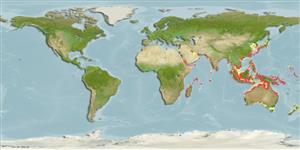分类 / Names
俗名 | 同种异名 | Catalog of Fishes(属, 种) | ITIS | CoL | WoRMS | Cloffa
Teleostei >
Carangiformes (Jacks)
鱸形目 (Jacks) >
Carangidae (Jacks and pompanos) > Caranginae
Etymology: Atropus: The name of the Parcae, fates of Roman mythology (Ref. 45335).
More on authors: Bloch & Schneider.
Environment: milieu / climate zone / depth range / distribution range
生态学
海洋; 非产卵性溯降河的 (Ref. 51243); 深度上下限 5 - 100 m (Ref. 52753). 热带; 40°N - 12°S, 47°E - 143°E
Indo-West Pacific.
印度-西太平洋: 在热带水域中, 北至三重县府,日本。
Length at first maturity / 大小 / 重量 / 年龄
Maturity: Lm 21.0 range ? - ? cm
Max length : 31.6 cm TL 雄鱼/尚未辨别雌雄; (Ref. 121654)
背棘 (总数): 9; 背的软条 (总数): 21-22; 臀棘 3; 臀鳍软条: 17 - 18. This species is easily recognized by its long pelvic fin which fit into a groove along the midline of the belly when depressed. Scutes are present along its straight lateral line. Adult males have prolonged middle rays in the soft dorsal and anal fins. This species attains 25 cm in SL.
当扁平的,这种容易鉴别的特徵为嵌入的它的长腹鳍 , 一个凹槽沿着腹面的中线。 鳞甲出现沿着它的直侧线。 雄性成鱼在软的背鳍与臀鳍中有特别长的中央鳍条。 这种达到 25 公分标准体长。
Adults are common in shallow coastal waters where they often swim near the surface. They feed mainly on shrimps, copepods, decapod crustaceans and small fish.
常见于沿岸浅水区在哪里它时常在表面巡游。 主要吃虾,桡脚类的动物,十足目甲壳动物与小鱼。
Life cycle and mating behavior
成熟度 | 繁殖 | 产卵场 | 卵 | 孕卵数 | 仔鱼
印度-西太平洋: 在热带水域中, 北至三重县府,日本。
Masuda, H., K. Amaoka, C. Araga, T. Uyeno and T. Yoshino, 1984. The fishes of the Japanese Archipelago. Vol. 1. Tokai University Press, Tokyo, Japan. 437 p. (text). (Ref. 559)
人类利用
渔业: 低经济
更多信息
参考文献养殖养殖信息品种遗传学Electrophoreses遗传率疾病加工NutrientsMass conversion
合作者照片Stamps, Coins Misc.声音神经毒速度泳型鳃区Otoliths脑重体重比眼睛色素
工具
特别资料
下载 XML
网络资源
Estimates based on models
Preferred temperature (Ref.
123201): 23.5 - 29.2, mean 28.2 °C (based on 1522 cells).
Phylogenetic diversity index (Ref.
82804): PD
50 = 1.0000 [Uniqueness, from 0.5 = low to 2.0 = high].
Bayesian length-weight: a=0.02089 (0.01183 - 0.03689), b=2.87 (2.72 - 3.02), in cm total length, based on LWR estimates for this species & (Sub)family-body (Ref.
93245).
营养阶层 (Ref.
69278): 3.6 ±0.52 se; based on food items.
Generation time: 2.0 ( na - na) years. Estimated as median ln(3)/K based on 1
growth studies.
回复力 (Ref.
120179): 高度, 族群倍增时间少于 15个月 (Preliminary K or Fecundity.).
Fishing Vulnerability (Ref.
59153): Low to moderate vulnerability (25 of 100).
Nutrients (Ref.
124155): Calcium = 197 [92, 426] mg/100g; Iron = 1.79 [0.95, 3.80] mg/100g; Protein = 18.6 [17.3, 19.9] %; Omega3 = 0.247 [0.129, 0.485] g/100g; Selenium = 51 [23, 115] μg/100g; VitaminA = 14.4 [3.5, 52.1] μg/100g; Zinc = 1.14 [0.73, 1.81] mg/100g (wet weight);
